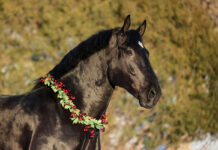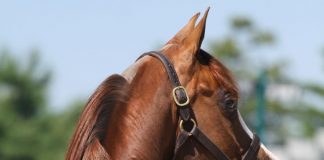From the heather-dotted moors of Scotland to the lumber camps of the American Midwest, the draft horse has made its mark all over the world. For centuries, draft horses have completed the strenuous work of clearing and plowing fields, pulling heavy wagons, and hauling logs in forests. No matter what the task, the draft horse has always risen to the occasion and steadily and quietly done its job, earning respect and admiration along the way.

Although advancements in mechanization during the early 20th century reduced the need for draft horses in the agricultural world, these treasured breeds still participate in farming activities today, thanks to dedicated enthusiasts who appreciate the beauty and power of farming with horses. But today’s draft horse is just as likely to be found in the show ring, competing as a part of a draft hitch at county fairs and larger competitive venues across the country.
Draft horses are also an integral part of the agritourism movement, as their gentle dispositions make them the perfect choice for introducing families to farm life and the joy of horses. And despite the undeniable power of trucks and tractors, some loggers have discovered that they prefer the company of draft horses when working in the forest.

Belgian Fast Facts
- The Belgian Draft Horse Corporation of America calls its breed “America’s Favorite Draft Horse.”
- In Belgium, the breed is known as the Brabant. (In America, the Brabant is often called the European Belgian.)
- While the Belgian is almost exclusively chestnut, Brabants are found in various colors, including roan.
- Belgian Draft Horse Corporation of America www.belgiancorp.com
In 2010, Guinness World Records recognized a Belgian named Big Jake as the tallest living horse. Big Jake stands at an impressive 20 hands, 2 ¾” tall at the withers (6’10”) and weighs 2,600 pounds. He is owned by Smokey Hollow Farm in Wisconsin.
American Cream Draft
- There are currently only about 200 American Cream Drafts.
- The American Cream Draft must exhibit amber eyes, pink skin and a cream-colored coat.
- The foundation mare of the American Cream Draft breed was “Old Granny,” a mare that was purchased in 1911 at a horse auction in Iowa.
- Genetic testing has shown that the American Cream Draft’s unique coloring is not the result of the cream gene, which produces palomino horses, but rather the champagne gene.
- Genetic testing has also shown that the American Cream Draft is its own distinct breed, as opposed to merely cream-colored horses of other draft breeds.
- American Cream Draft Horse Association www.acdha.org

Suffolk Punch
- The Suffolk Punch is always a shade of chestnut, but the color is spelled “chesnut” within the breed sphere.
- All of today’s Suffolk Punch horses descend from the breed’s foundation stallion, Thomas Crisp’s Horse of Ufford, dating back to the 1700s.
- According to the American Suffolk Horse Association, there are approximately 800 to 1,200 Suffolk horses in the United States and an estimated 150 in England, the breed’s homeland.
- American Suffolk Horse Association www.suffolkpunch.com

Clydesdale
- The Clydesdale is most popularly associated with Super Bowl commercials. To qualify as a Budweiser Clydesdale, each horse must be a gelding and stand at least 18 hands tall.
- The basin of the River Clyde is located in Lanarkshire, Scotland, the birthplace of the Clydesdale horse.
- Clydesdale Breeders of the U.S.A.
www.clydesusa.com
Click here to meet the Express Clydesdale hitch of Oklahoma.
North American Spotted Draft
- Before being registered with the North American Spotted Draft Horse Association (NASDHA), horses must meet the registry’s minimum requirement for white markings.
- Eighty horses were registered with the NASDHA in 2012.
- North American Spotted Draft Horse Association
nasdha.org

Shire
- In England, the word “shire” means “county.” The breed’s name thus recognizes its rural British roots.
- During the Industrial Revolution, the Shire towed large barges through England’s canals. They later pulled omnibuses and trams in the cities.
- According to the American Livestock Breeds Conservancy, the Shire became almost extinct in the United States during the 1950s. While the numbers have increased in subsequent years, the breed is still rarer than some of the other draft breeds.
- American Shire Horse Association www.shirehorse.org

Percheron
- The Percheron contains Arabian influence, which is noticeable in the breed’s movement and attractive head, as well as the frequency of gray coloring within the breed.
- Percherons that once pulled heavy stage coaches were called diligence horses. (Stage coaches were known as diligences in France, where the breed originated.) They could trot at 7 to 10 mph for long periods of time, and the light-colored horses were preferred for nighttime drives.
- Percheron Horse Association of America www.percheronhorse.org

Tap here to learn more about draft horse hitches and their terminology.
This article originally appeared in the December 2013 issue of Horse Illustrated magazine. Click here to subscribe!






Wow, I so love the draughts
It appears there is discrepancy in the facts about the largest horse, Big Jake at 20 hands tall and Zeus another Belgian at 21.5 hands tall
The word “team” refers to a group, not a pair and is used incorrectly in the Draft Hitches 101 section. Two horses side by side is a pair. Two pair make a four horse hitch (or team). Two pair with one pair in front of the other is a four in hand. The horses could also be four abreast, or four wide.